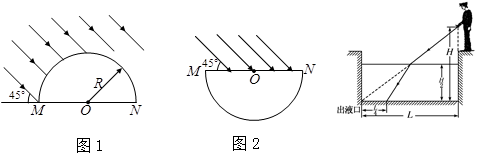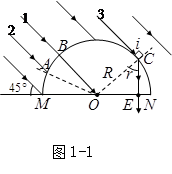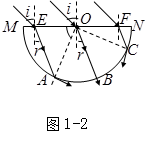半径为R的半圆柱形玻璃砖,横截面如图1所示,O为圆心.已知玻璃的折射率为 .一束与MN平面成450的平行光束射到玻璃砖的半圆柱面上,经玻璃折射后,有部分光能从MN平面上射出.
.一束与MN平面成450的平行光束射到玻璃砖的半圆柱面上,经玻璃折射后,有部分光能从MN平面上射出.
(1)求能从MN平面射出的光束的宽度为多少?
 (2)如果平行光束是以45°角从空气射到半圆柱的平面表面上,如图2所示,设此时从半圆柱面上出射光束的位置与圆心O的连线跟MO夹角为φ,试求φ的范围.
(2)如果平行光束是以45°角从空气射到半圆柱的平面表面上,如图2所示,设此时从半圆柱面上出射光束的位置与圆心O的连线跟MO夹角为φ,试求φ的范围.
(1) (2)
(2)
(1) 图1-1中,BO为沿半径方向入射的光线,在O点正好发生全反射, ---------(1分)
入射光线③在C点与球面相切,此时入射角 ,折射角为r,则有
,折射角为r,则有



即  ---------(2分)
---------(2分)
这表示在C点折射的光线将垂直MN射出,与MN相交于E点。MN面上OE即是出射光的宽度。 ---------(1分)
 ---------(1分)
---------(1分)
(2)如图1-2所示,由折身定律 ,
,
得 ,
, , ---------(1分)
, ---------(1分)
如果光线EA刚好在A点发生全反射,则有

 ,而
,而 ,
,
即有 ---------(1分)
---------(1分)
此时<EOA=75° ---------(1分)
因EA与OB平行,所以
如果光线FC刚好在C点发生全反射,则有
 --------(1分)
--------(1分)
此时 ---------(1分)
---------(1分)
故知能够从半圆柱球面上出射的光束范围限制在AC区域上,对应的角度为 ---------(1分)
---------(1分)
本题考查全反射发生的条件和光路图的画法,先画出光路图,再根据几何关系求得
